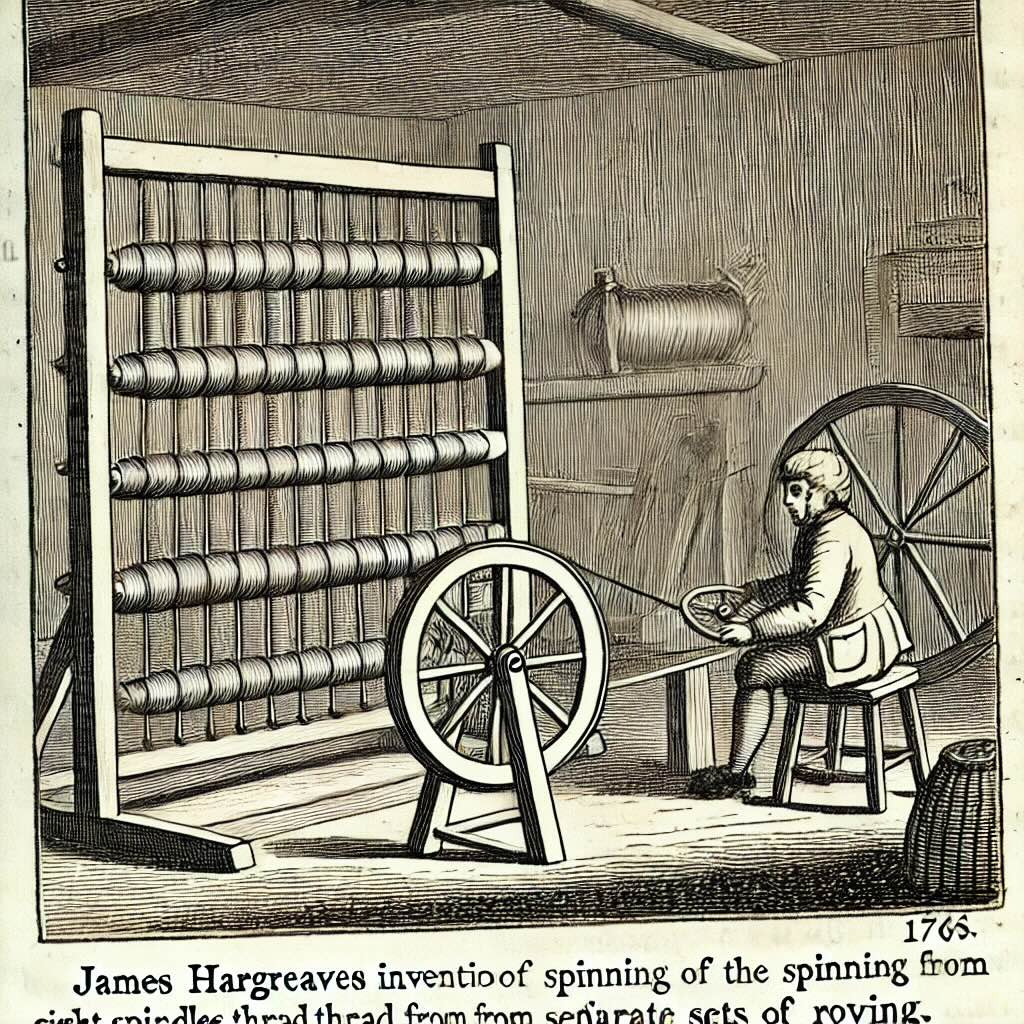
The introduction of the flying shuttle had increased the demand for cotton thread. James Hargreaves invented the Spinning Jenny in 1764 to meet that demand. The Spinning Jenny allowed eight spindles into which thread could be spun from eight sets of ravings. Thus an operator could spin a wheel and thus spin eight threads at the same time.
The invention of the Flying Shuttle by John Kay in 1733 revolutionized the weaving industry, allowing looms to work faster and produce larger quantities of cloth. However, this advancement created a problem for spinners. The faster and more efficient looms now demanded more thread than traditional spinning methods could supply. This growing imbalance between weaving and spinning prompted the need for a new invention to keep up with the increased demand for thread. In response to this need, James Hargreaves, a weaver and carpenter from Lancashire, invented the Spinning Jenny in 1764.
Before Hargreaves’ invention, spinning was a slow, labor-intensive process. Spinners could only operate one spindle at a time, producing one thread at a time. As a result, the supply of thread lagged behind the needs of the weavers, causing bottlenecks in textile production. Hargreaves sought to change this by designing a machine that could spin multiple threads simultaneously.
The Spinning Jenny was a remarkable breakthrough in textile technology. Hargreaves’ invention allowed a single operator to spin multiple threads at once, greatly increasing productivity. Originally, the Spinning Jenny had eight spindles, meaning that one person could spin eight threads simultaneously from a single wheel. The machine used a hand-operated wheel that, when turned, moved the spindles. Each spindle was connected to rovings (loosely twisted strands of fibers), and the spinning process twisted the fibers into yarn or thread. This innovation enabled spinners to produce much more thread than before, and it significantly reduced the amount of time and labor required to create yarn.
The impact of the Spinning Jenny was profound. It addressed the shortage of thread caused by the Flying Shuttle and helped meet the growing demand for yarn in the rapidly expanding textile industry. Not only did it improve the productivity of individual spinners, but it also laid the foundation for further advancements in spinning technology. Over time, the number of spindles on the Spinning Jenny increased, with later versions featuring up to 80 or more spindles, drastically boosting output.
However, like many technological innovations, the Spinning Jenny was not without controversy. Hargreaves’ invention threatened the livelihoods of traditional spinners who worked by hand. Many spinners feared that the widespread adoption of the Spinning Jenny would lead to unemployment and lower wages. In some cases, this fear turned to violence. In 1768, angry mobs of spinners broke into Hargreaves’ home and destroyed several of his machines. Despite this resistance, the Spinning Jenny proved too valuable to the growing textile industry to be abandoned.
The invention of the Spinning Jenny also marked a significant step toward the Industrial Revolution. As the machine became more widespread, it contributed to the transformation of the textile industry from a cottage-based, handcraft industry to a mechanized, factory-based system. Factories equipped with Spinning Jennies and other spinning machines began to emerge, shifting production from small workshops and homes to large industrial centers.
In the larger historical context, James Hargreaves’ Spinning Jenny played a key role in advancing industrialization. It was one of the first machines to mechanize a process that had been done manually for centuries, helping to pave the way for later innovations like Richard Arkwright’s water frame and Samuel Crompton’s spinning mule, which further revolutionized textile manufacturing.
Though James Hargreaves did not achieve great wealth from his invention, the Spinning Jenny remains one of the most important inventions in the history of the textile industry. It solved a critical production bottleneck and significantly increased the supply of yarn, making it a key component of the Industrial Revolution. The impact of the Spinning Jenny extended beyond textiles, as it helped fuel the growth of industries that relied on cloth, such as clothing, upholstery, and ship sails, further accelerating industrial and economic progress.
 >
>